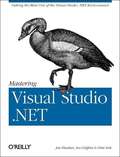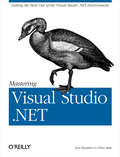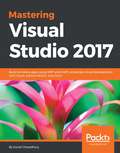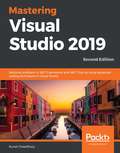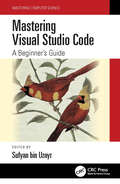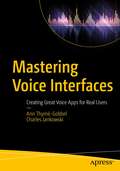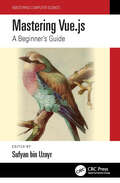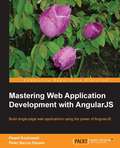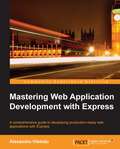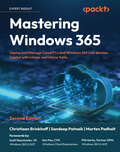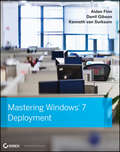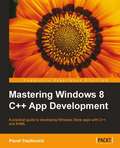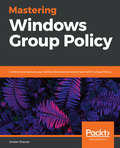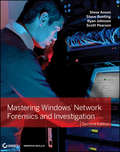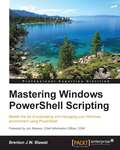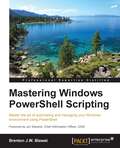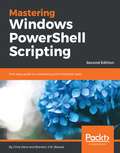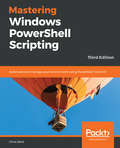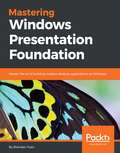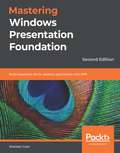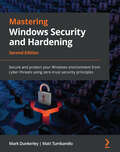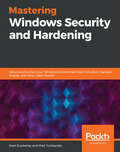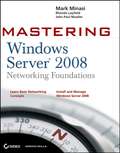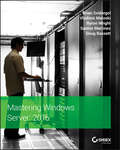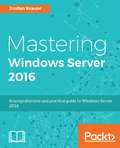- Table View
- List View
Mastering Visual Studio .NET
by Jon Flanders Chris SellsMastering Visual Studio .NETprovides you, as an experienced programmer, with all the information needed to get the most out of the latest and greatest development tool from Microsoft®. Written by experienced developers and trainers John Flanders, Ian Griffiths, and Chris Sells, this book not only covers the fundamentals, but also shows how to customize and extend the toolkit to your specific needs.
Mastering Visual Studio .NET: Getting the Most Out of the Visual Studio .NET Environment (O'reilly Ser.)
by Jon Flanders Chris Sells Ian Griffiths<p><i>Mastering Visual Studio .NET</i> provides you, as an experienced programmer, with all the information needed to get the most out of the latest and greatest development tool from Microsoft®. Written by experienced developers and trainers John Flanders, Ian Griffiths, and Chris Sells, this book not only covers the fundamentals, but also shows how to customize and extend the toolkit to your specific needs.</p>
Mastering Visual Studio 2017
by Kunal ChowdhuryA guide to mastering Visual Studio 2017 About This Book • Focus on coding with the new, improved, and powerful tools of VS 2017 • Master improved debugging and unit testing support capabilities • Accelerate cloud development with the built-in Azure tools Who This Book Is For .NET Developers who would like to master the new features of VS 2017, and would like to delve into newer areas such as cloud computing, would benefit from this book. Basic knowledge of previous versions of Visual Studio is assumed. What You Will Learn • Learn what's new in the Visual Studio 2017 IDE, C# 7.0, and how it will help developers to improve their productivity • Learn the workloads and components of the new installation wizard and how to use the online and offline installer • Build stunning Windows apps using Windows Presentation Foundation (WPF) and Universal Windows Platform (UWP) tools • Get familiar with .NET Core and learn how to build apps targeting this new framework • Explore everything about NuGet packages • Debug and test your applications using Visual Studio 2017 • Accelerate cloud development with Microsoft Azure • Integrate Visual Studio with most popular source control repositories, such as TFS and GitHub In Detail Visual Studio 2017 is the all-new IDE released by Microsoft for developers, targeting Microsoft and other platforms to build stunning Windows and web apps. Learning how to effectively use this technology can enhance your productivity while simplifying your most common tasks, allowing you more time to focus on your project. With this book, you will learn not only what VS2017 offers, but also what it takes to put it to work for your projects. Visual Studio 2017 is packed with improvements that increase productivity, and this book will get you started with the new features introduced in Visual Studio 2017 IDE and C# 7.0. Next, you will learn to use XAML tools to build classic WPF apps, and UWP tools to build apps targeting Windows 10. Later, you will learn about .NET Core and then explore NuGet, the package manager for the Microsoft development platform. Then, you will familiarize yourself with the debugging and live unit testing techniques that comes with the IDE. Finally, you'll adapt Microsoft's implementation of cloud computing with Azure, and the Visual Studio integration with Source Control repositories. Style and approach This comprehensive guide covers the advanced features of Visual Studio 2017, and communicates them through a practical approach to explore the underlying concepts of how, when, and why to use it.
Mastering Visual Studio 2019 - Second Edition
by Kunal ChowdhuryMicrosoft .NET Developers who would like to learn the new features of Visual Studio 2019, and would like to delve into newer areas such as cloud computing, .NET Core, TypeScript, along with mastering the skills of building, debugging and unit testing professional apps, would benefit from this book. Basic knowledge of Visual Studio, .NET and C# is assumed.
Mastering Visual Studio Code: A Beginner's Guide (Mastering Computer Science)
by Sufyan Bin UzayrMastering Visual Studio Code empowers the readers to get the most out of VS Code, an extremely popular and powerful code editor. Microsoft’s Visual Studio Code (VS Code) is a free and open-source code and text editor. Despite its modest size, VS Code includes numerous significant features that have made it one of the most popular code editors in recent years. VS Code is compatible with various programming languages, including Java, C++, Python, CSS, Go, and Docker files. VS Code also lets you add and create new extensions, such as code linkers, debuggers, and support for cloud and web development. Compared to other text editors, the VS Code user interface allows for a lot of interactivity. Some of the major advantages of Visual Studio Code are: • Cross-stack development using an open technology platform • Huge repository of plug-ins produced by the community and professionals • Debug tools for generic usage • Cross-platform support, including Linux, Mac, and Windows A good and powerful code editor is a vital part of any developer’s toolkit. VS Code has all the features any developer might need. As such, learning Visual Studio Code and understanding its various offerings and features is a good idea. With Mastering Visual Studio Code, using VS Code will become a breeze, regardless of the language that you are coding in, thereby boosting your productivity. The Mastering Computer Science series is edited by Sufyan bin Uzayr, a writer and educator with more than a decade of experience in the computing field.
Mastering Voice Interfaces: Creating Great Voice Apps for Real Users
by Ann Thymé-Gobbel Charles JankowskiBuild great voice apps of any complexity for any domain by learning both the how's and why's of voice development. In this book you’ll see how we live in a golden age of voice technology and how advances in automatic speech recognition (ASR), natural language processing (NLP), and related technologies allow people to talk to machines and get reasonable responses. Today, anyone with computer access can build a working voice app. That democratization of the technology is great. But, while it’s fairly easy to build a voice app that runs, it's still remarkably difficult to build a great one, one that users trust, that understands their natural ways of speaking and fulfills their needs, and that makes them want to return for more. We start with an overview of how humans and machines produce and process conversational speech, explaining how they differ from each other and from other modalities. This is the background you need to understand the consequences of each design and implementation choice as we dive into the core principles of voice interface design. We walk you through many design and development techniques, including ones that some view as advanced, but that you can implement today. We use the Google development platform and Python, but our goal is to explain the reasons behind each technique such that you can take what you learn and implement it on any platform. Readers of Mastering Voice Interfaces will come away with a solid understanding of what makes voice interfaces special, learn the core voice design principles for building great voice apps, and how to actually implement those principles to create robust apps. We’ve learned during many years in the voice industry that the most successful solutions are created by those who understand both the human and the technology sides of speech, and that both sides affect design and development. Because we focus on developing task-oriented voice apps for real users in the real world, you’ll learn how to take your voice apps from idea through scoping, design, development, rollout, and post-deployment performance improvements, all illustrated with examples from our own voice industry experiences. What You Will Learn Create truly great voice apps that users will love and trust See how voice differs from other input and output modalities, and why that matters Discover best practices for designing conversational voice-first applications, and the consequences of design and implementation choices Implement advanced voice designs, with real-world examples you can use immediately. Verify that your app is performing well, and what to change if it doesn't Who This Book Is For Anyone curious about the real how’s and why’s of voice interface design and development. In particular, it's aimed at teams of developers, designers, and product owners who need a shared understanding of how to create successful voice interfaces using today's technology. We expect readers to have had some exposure to voice apps, at least as users.
Mastering Vue.js: A Beginner's Guide (Mastering Computer Science)
by Sufyan Bin UzayrMastering Vue.js helps the reader master the Vue.js JavaScript framework for faster and more robust front-end development. Vue is a popular JavaScript front-end framework that is rapidly expanding. It is easy to use, small (less than 24 KB), and really fast. It is simple to include in other applications and libraries. Vue.js is easy to install, and beginners may quickly learn how to use it and begin creating their interface design. What makes Vue special is that it is different from most other JavaScript frameworks and libraries. Unlike other monolithic frameworks, Vue is built from the ground up to be incrementally adaptable. The core library focuses primarily on the View layer, and is easy to use and combine with other libraries or projects. On the other hand, when merged with contemporary stacks and libraries, Vue is perfectly capable of running powerful Single-Page Web Applications. Working with Vue.js can be fun. Leveraging Vue and its plugins can help one easily create excellent Internet and smartphone-compatible applications. Vue is both compact and customizable, and comes with multiple capabilities for intelligent state management and navigation choices. All said and done, learning Vue is an excellent career initiative, especially since it is rapidly gaining favor among startups and established enterprises alike. Vue is an excellent choice if you want to make a highly engaging, flexible, and data-driven app. It has an easy-to-understand layout which you can learn in minutes. Unlike Angular or React, Vue.js does not have a lot of challenges or concepts to master. It is an excellent choice for programmers looking to learn and implement new technology for their next project. With Mastering Vue.js, learning Vue becomes very straightforward, which will help readers undoubtedly advance their careers. The Mastering Computer Science series is edited by Sufyan bin Uzayr, a writer and educator with over a decade of experience in the computing field.
Mastering Web Application Development with AngularJS
by Pawel Kozlowski Peter Bacon DarwinThe book will be a step-by-step guide showing the readers how to build a complete web app with AngularJSJavaScript developers who want to learn AngularJS for developing web apps. Knowledge of JavaScript and HTML is expected. No knowledge of AngularJS is required.
Mastering Web Application Development with Express
by Alexandru VladutuIf you are a Node.js developer who wants to take your Express skills to the next level and develop high performing, reliable web applications using best practices, this book is ideal for you. The only prerequisite is knowledge of Node.js.
Mastering Windows 365: Deploy and Manage Cloud PCs and Windows 365 Link devices, Copilot with Intune, and Intune Suite
by Christiaan Brinkhoff Sandeep Patnaik Morten PedholtUnlock advanced IT Pro skills for Windows 365, Intune, Intune Suite, Microsoft Copilot, AI PCs, and more—build expertise from the ground up!Key FeaturesPractical guide to deploying and managing Windows 365 cloud PCs with real-world scenariosDetailed coverage of advanced features, including Microsoft Intune, Graph API, and Security CopilotInsights from Microsoft experts who played a key role in shaping Windows 365 and Azure Virtual DesktopBook DescriptionWindows 365 Cloud PC continues to evolve, integrating AI-driven management, enhanced security, and expanded capabilities to provide a seamless cloud-based Windows experience. This second edition builds on the foundation of the first, incorporating new content on Intune Suite, Copilot+ AI PCs, Windows App, and advanced security with Security Copilot to help IT professionals deploy, manage, and optimize Windows 365 Cloud PCs effectively. This edition expands beyond the basics, covering Intune Suite’s role in optimizing and securing deployments, new methods for application management and delivery, and insights into Windows 365 Link for hybrid cloud environments. You’ll also explore AI-powered administration with Security Copilot, providing intelligent security management and automation. Written by experts from the Windows 365 product team and a Microsoft MVP, this book provides practical guidance, best practices, and real-world insights to help you master modern Windows cloud management. Whether you’re working with Windows 365, Intune Suite, or AI-powered administration, this guide equips you with the latest tools and strategies to stay ahead in cloud computing.What you will learnDeploy and configure Windows 365 cloud PCs for a seamless cloud experienceManage and secure cloud PCs using Microsoft IntuneAutomate workflows with Microsoft Graph to improve efficiencyStrengthen security with Copilot in Intune and Microsoft security protocolsOptimize performance, diagnose issues, and troubleshoot cloud environmentsExplore future advancements in cloud computing and Windows 365Secure Windows 365 Cloud PC connections using best practicesWho this book is forThis book is for IT administrators, architects, consultants, and CIOs looking to leverage and design Windows 365 cloud PCs effectively and train for the Modern Desktop MD-102 Administrator certification. This book is also for anyone seeking to move their virtualization or Windows endpoints to the cloud with ease. Basic understanding of modern management based on Microsoft Intune and Microsoft 365 is required.
Mastering Windows 7 Deployment
by Darril Gibson Aidan Finn Kenneth van SurksumGet professional-level instruction on Windows 7 deployment tools Enterprise-level operating system deployment is challenging and requires knowledge of specific tools. It is expected that Windows 7 will be extensively deployed in businesses worldwide. This comprehensive Sybex guide provides thorough coverage of the Microsoft deployment tools that were specifically created for Windows 7, preparing system administrators, MIS professionals, and corporate programmers to tackle the task effectively. Companies worldwide are expected to deploy Windows 7 as their enterprise operating system; system administrators and IT professionals need comprehensive instruction on Microsoft’s deployment tools This complete guide provides clear, step-by-step instruction on planning, installing, configuring, deploying, and troubleshooting deployment methods for each tool Covers the Microsoft Assessment and Planning (MAP) Toolkit, Application Compatibility Toolkit (ACT), Windows PE, Windows Automated Installation Kit (WAIK), Windows System Image Manager (WSIM), Easy Transfer, User State Migration Toolkit (USMT), Windows Deployment Services, Microsoft Deployment Toolkit 2010, System Center Configuration Manager, Key Management Service, and Volume Activation Management Tool (VAMT) Illustrated with plenty of real-world scenarios, Mastering Windows Deployment provides the hands-on instruction you need to fully understand and use each deployment technology.
Mastering Windows 8 C++ App Development
by Pavel YosifovichSpecifically designed to be an engaging and practical tutorial, Mastering Windows 8 C++ App Development will augment your skills and help you create high quality Windows Store apps.If you are a C++ developer who wants to utilize the combined power of COM, WinRT, C++/CX, and XAML to build Store apps for the new Windows 8 platform, then this book is for you. Prior experience with XAML-based technologies is not required.
Mastering Windows Group Policy: Control and secure your Active Directory environment with Group Policy
by Jordan KrauseIf you are an IT professional who works with Windows Servers or are interested in an Active Directory environment then this book is for you. General knowledge of Microsoft Windows, how Windows Server fits into an enterprise's infrastructure and also some existing knowledge of an Active Directory domain environment is expected.
Mastering Windows Network Forensics and Investigation
by Scott Pearson Steve Bunting Steven Anson Ryan JohnsonAn authoritative guide to investigating high-technology crimesInternet crime is seemingly ever on the rise, making the need for a comprehensive resource on how to investigate these crimes even more dire. This professional-level book--aimed at law enforcement personnel, prosecutors, and corporate investigators--provides you with the training you need in order to acquire the sophisticated skills and software solutions to stay one step ahead of computer criminals. Specifies the techniques needed to investigate, analyze, and document a criminal act on a Windows computer or networkPlaces a special emphasis on how to thoroughly investigate criminal activity and now just perform the initial responseWalks you through ways to present technically complicated material in simple terms that will hold up in courtFeatures content fully updated for Windows Server 2008 R2 and Windows 7Covers the emerging field of Windows Mobile forensicsAlso included is a classroom support package to ensure academic adoption, Mastering Windows Network Forensics and Investigation, 2nd Edition offers help for investigating high-technology crimes.
Mastering Windows PowerShell Scripting
by Brenton Blawat<P><P>Master the art of automating and managing your Windows environment using PowerShell <P><P>About This Book <P><P>Construct scripts by following proven best practices to automate redundant tasks <P><P>Delve into real-world examples to understand how to simplify the management of your Windows environment <P><P>Get to grips with PowerShell's advanced functions and effectively administer your system <P><P>Who This Book Is For <P><P>If you are a system administrator who wants to become an expert in controlling and automating your Windows environment, then this book is for you. Prior knowledge of PowerShell's core elements and applications is required for this book. <P><P>What You Will Learn <P><P>Utilize variables, hashes, and arrays to store data <P><P>Parse and manipulate different data types <P><P>Optimize code through the use of functions, switches, and looping structures <P><P>Create and implement regular expressions in PowerShell scripts <P><P>Leverage session-based remote management <P><P>Manage files, folders, and registries through the use of PowerShell <P><P>Discover the best practices to manage Microsoft systems <P><P>In Detail <P><P>PowerShell is quickly becoming the de facto standard for scripting in Microsoft Windows environments. It enables the automation of otherwise complex tasks, providing interactivity between different products. <P><P>Beginning with PowerShell fundamentals, this book progresses by imparting the advanced skills required to master automation. You will learn how to deal with data and operations on various data types and structures, and see the techniques of data manipulation and parsing. Moving on, you will learn about the usage of regular expressions and comparison operators. Error handling techniques will enable you to identify and eliminate errors. This book also provides best practices for scripting and techniques to reduce the amount of code required to complete tasks. <P><P>By the end of this book, you will be able to create a variety of PowerShell scripts and successfully automate your environment and become the go-to person.
Mastering Windows PowerShell Scripting
by Brenton J.W. BlawatIf you are a system administrator who wants to become an expert in controlling and automating your Windows environment, then this book is for you. Prior knowledge of PowerShell's core elements and applications is required for this book.
Mastering Windows PowerShell Scripting - Second Edition
by Brenton J.W. Blawat Chris DentMaster the art of automating and managing your environment using PowerShell About This Book • Find quick solutions to automate your environment with ease • Work with large amounts of data effortlessly with PowerShell data types and secure them • Packed with real-world examples to automate and simplify the management of your Windows environment Who This Book Is For If you are a system administrator who wants to become an expert in controlling and automating your Windows environment, then this book is for you. It is also for those new to the PowerShell language. What You Will Learn • Optimize code through the use of functions, switches, and looping structures • Install PowerShell on your Linux system • Utilize variables, hashes, and arrays to store data • Work with Objects and Operators to test and manipulate data • Parse and manipulate different data types • Write .NET classes with ease within the PowerShell • Create and implement regular expressions in PowerShell scripts • Deploy applications and code with PowerShell's Package management modules • Leverage session-based remote management • Manage files, folders, and registries through the use of PowerShell In Detail PowerShell scripts offer a handy way to automate various chores. Working with these scripts effectively can be a difficult task. This comprehensive guide starts from scratch and covers advanced-level topics to make you a PowerShell expert. The first module, PowerShell Fundamentals, begins with new features, installing PowerShell on Linux, working with parameters and objects, and also how you can work with .NET classes from within PowerShell. In the next module, you'll see how to efficiently manage large amounts of data and interact with other services using PowerShell. You'll be able to make the most of PowerShell's powerful automation feature, where you will have different methods to parse and manipulate data, regular expressions, and WMI. After automation, you will enter the Extending PowerShell module, which covers topics such as asynchronous processing and, creating modules. The final step is to secure your PowerShell, so you will land in the last module, Securing and Debugging PowerShell, which covers PowerShell execution policies, error handling techniques, and testing. By the end of the book, you will be an expert in using the PowerShell language. Style and approach This practical guide covers all the advanced PowerShell functionalities that an administrator needs to learn to automate their environments.
Mastering Windows PowerShell Scripting: Automate and manage your environment using PowerShell Core 6.0, 3rd Edition
by Chris DentGrasp advanced PowerShell Core 6.0 functionalities to automate your environmentKey FeaturesKeep up with changes introduced in PowerShell Core 6.0Easily maintain appropriate compatibility with older versionsAutomate complex tasks, manipulate data, and secure your environment with PowerShell Core 6.0Book DescriptionPowerShell scripts offer a handy way to automate various chores, however working effectively with these scripts can be a difficult task.This comprehensive guide starts with the fundamentals before moving on to advanced-level topics to help you become a PowerShell Core 6.0 expert. The first module, PowerShell Core 6.0 Fundamentals, begins with the new features of PowerShell Core 6.0, installing it on Linux, and working with parameters, objects and .NET classes from within PowerShell Core 6.0. As you make your way through the chapters, you'll see how to efficiently manage large amounts of data and interact with other services using PowerShell Core 6.0. You'll be able to make the most of PowerShell Core 6.0's powerful automation feature, where you will have different methods available to parse data and manipulate regular expressions and Windows Management Instrumentation (WMI). After having explored automation, you will enter the extending PowerShell Core 6.0 module, covering asynchronous processing and desired state configuration. In the last module, you will learn to extend PowerShell Core 6.0 using advanced scripts and filters, and also debug issues along with working on error handling techniques.By the end of this book, you will be an expert in scripting with PowerShell Core 6.0.What you will learnOptimize code through the use of functions, switches, and looping structuresWork with objects and operators to test and manipulate dataParse and manipulate different data typesCreate scripts and functions using PowerShellUse jobs, events, and popular public modules which assist with implementing multithreadingWrite .NET classes with ease within the PowerShellCreate and implement regular expressions in PowerShell scriptsMake use of advanced techniques to define and restrict the behavior of parametersWho this book is forIf you are a system administrator who wants to become an expert in controlling and automating your Windows environment, then Mastering Windows PowerShell Scripting is for you. It is also ideal for those new to the PowerShell language.
Mastering Windows Presentation Foundation
by Sheridan YuenMaster the art of building modern desktop applications on Windows About This Book • Learn how to use the MVVM software architectural pattern and see the benefits of using it with Windows Presentation Fountain (WPF) • Explore various ways to enhance efficiency through performance tuning and UI automation • Obtain a deep understanding of data validation and understand various methods that suit different situations Who This Book Is For This book is for working developers with a moderate level of knowledge about Windows Presentation Foundation. It will also be of special interest to ambitious individuals who want to know more about application architecture. It is also suitable for those who just want to learn how to build visually stunning user interfaces. What You Will Learn • Use MVVM to improve workflow • Create visually stunning user interfaces • Perform data binds proficiently • Implement advanced data validation • Locate and resolve errors quickly • Master practical animations • Improve your applications' performance In Detail Windows Presentation Foundation is rich in possibilities when it comes to delivering an excellent user experience. This book will show you how to build professional-grade applications that look great and work smoothly. We start by providing you with a foundation of knowledge to improve your workflow – this includes teaching you how to build the base layer of the application, which will support all that comes after it. We'll also cover the useful details of data binding. Next, we cover the user interface and show you how to get the most out of the built-in and custom WPF controls. The final section of the book demonstrates ways to polish your applications, from adding practical animations and data validation to improving application performance. The book ends with a tutorial on how to deploy your applications and outlines potential ways to apply your new-found knowledge so you can put it to use right away. The book also covers 2D and 3D graphics, UI automation, and performance tuning. Style and approach Filled with intriguing and practical examples, this book delineates concepts that will help you take your WPF skills to the next level.
Mastering Windows Presentation Foundation: Build responsive UIs for desktop applications with WPF, 2nd Edition
by Sheridan YuenGain the expertise you need to build custom application frameworks and responsive and visually appealing user interfaces with WPF, C#, and .NET Key Features Discover a smarter way of working with WPF using the MVVM software architectural pattern Create your own lightweight application framework to build your future applications upon Understand data binding and learn how to use it in an application Book Description Microsoft Windows Presentation Foundation (WPF) provides several libraries and APIs for developers to create engaging user experiences. This book features a wide range of simple through to complex examples to demonstrate how to develop enterprise-grade applications for Windows desktop with WPF. This updated second edition of Mastering Windows Presentation Foundation starts by covering the benefits of using the Model-View-ViewModel (MVVM) software architectural pattern with WPF, before guiding you through debugging your WPF apps. The book will then take you through the application architecture and building the foundation layer for your apps. As you advance, you'll get to grips with data binding, explore the various built-in WPF controls, and customize them to suit your requirements. You'll learn how to create custom controls to meet your needs when the built-in functionality is not enough. You'll also learn how to enhance your applications using practical animations, stunning visuals, and responsive data validation. To ensure that your app is not only interactive but also efficient, you'll focus on improving application performance, and finally, discover the different methods for deploying your applications. By the end of this book, you'll be proficient in using WPF for developing efficient yet robust user interfaces. What you will learn Discover MVVM and how it assists development with WPF Implement your own custom application framework Become proficient with Data Binding Understand how to adapt the built-in controls Get up to speed with animations Implement responsive data validation Create visually appealing user interfaces Improve application performance Learn how to deploy your applications Who this book is for This Windows book is for developers with basic to intermediate-level knowledge of Windows Presentation Foundation and for those interested in simply enhancing their WPF skills. If you're looking to learn more about application architecture and designing user interfaces in a visually appealing manner, you'll find this book useful.
Mastering Windows Security and Hardening: Secure and protect your Windows environment from cyber threats using zero-trust security principles, 2nd Edition
by Mark Dunkerley Matt TumbarelloA comprehensive guide to administering and protecting the latest Windows 11 and Windows server operating system from ongoing cyber threats using zero-trust security principlesKey FeaturesLearn to protect your Windows environment using zero-trust and a multi-layered security approachImplement security controls using Intune, Configuration Manager, Defender for Endpoint, and moreUnderstand how to onboard modern cyber-threat defense solutions for Windows clientsBook DescriptionAre you looking for the most current and effective ways to protect Windows-based systems from being compromised by intruders? This updated second edition is a detailed guide that helps you gain the expertise to implement efficient security measures and create robust defense solutions using modern technologies. The first part of the book covers security fundamentals with details around building and implementing baseline controls. As you advance, you'll learn how to effectively secure and harden your Windows-based systems through hardware, virtualization, networking, and identity and access management (IAM). The second section will cover administering security controls for Windows clients and servers with remote policy management using Intune, Configuration Manager, Group Policy, Defender for Endpoint, and other Microsoft 365 and Azure cloud security technologies. In the last section, you'll discover how to protect, detect, and respond with security monitoring, reporting, operations, testing, and auditing. By the end of this book, you'll have developed an understanding of the processes and tools involved in enforcing security controls and implementing zero-trust security principles to protect Windows systems.What you will learnBuild a multi-layered security approach using zero-trust conceptsExplore best practices to implement security baselines successfullyGet to grips with virtualization and networking to harden your devicesDiscover the importance of identity and access managementExplore Windows device administration and remote managementBecome an expert in hardening your Windows infrastructureAudit, assess, and test to ensure controls are successfully applied and enforcedMonitor and report activities to stay on top of vulnerabilitiesWho this book is forIf you're a cybersecurity or technology professional, solutions architect, systems engineer, systems administrator, or anyone interested in learning how to secure the latest Windows-based systems, this book is for you. A basic understanding of Windows security concepts, Intune, Configuration Manager, Windows PowerShell, and Microsoft Azure will help you get the best out of this book.
Mastering Windows Security and Hardening: Secure and protect your Windows environment from intruders, malware attacks, and other cyber threats
by Mark Dunkerley Matt TumbarelloEnhance Windows security and protect your systems and servers from various cyber attacksKey FeaturesProtect your device using a zero-trust approach and advanced security techniquesImplement efficient security measures using Microsoft Intune, Configuration Manager, and Azure solutionsUnderstand how to create cyber-threat defense solutions effectivelyBook DescriptionAre you looking for effective ways to protect Windows-based systems from being compromised by unauthorized users? Mastering Windows Security and Hardening is a detailed guide that helps you gain expertise when implementing efficient security measures and creating robust defense solutions. We will begin with an introduction to Windows security fundamentals, baselining, and the importance of building a baseline for an organization. As you advance, you will learn how to effectively secure and harden your Windows-based system, protect identities, and even manage access. In the concluding chapters, the book will take you through testing, monitoring, and security operations. In addition to this, you'll be equipped with the tools you need to ensure compliance and continuous monitoring through security operations. By the end of this book, you'll have developed a full understanding of the processes and tools involved in securing and hardening your Windows environment.What you will learnUnderstand baselining and learn the best practices for building a baselineGet to grips with identity management and access management on Windows-based systemsDelve into the device administration and remote management of Windows-based systemsExplore security tips to harden your Windows server and keep clients secureAudit, assess, and test to ensure controls are successfully applied and enforcedMonitor and report activities to stay on top of vulnerabilitiesWho this book is forThis book is for system administrators, cybersecurity and technology professionals, solutions architects, or anyone interested in learning how to secure their Windows-based systems. A basic understanding of Windows security concepts, Intune, Configuration Manager, Windows PowerShell, and Microsoft Azure will help you get the best out of this book.
Mastering Windows Server 2008 Networking Foundations
by John Paul Mueller Mark Minasi Rhonda LayfieldFind in-depth coverage of general networking concepts and basic instruction on Windows Server 2008 installation and management including active directory, DNS, Windows storage, and TCP/IP and IPv4 networking basics in Mastering Windows Server 2008 Networking Foundations. One of three new books by best-selling author Mark Minasi, this guide explains what servers do, how basic networking works (IP basics and DNS/WINS basics), and the fundamentals of the under-the-hood technologies that support staff must understand. Learn how to install Windows Server 2008 and build a simple network, security concepts, and basic Windows Server administration.
Mastering Windows Server 2016
by Byron Wright Brian Svidergol Santos Martinez Vladimir Meloski Doug BassettThe IT pro's must-have guide to Windows Server 2016 Mastering Windows Server 2016 is a complete resource for IT professionals needing to get quickly up to date on the latest release. Designed to provide comprehensive information in the context of real-world usage, this book offers expert guidance through the new tools and features to help you get Windows Server 2016 up and running quickly. Straightforward discussion covers all aspects, including virtualization products, identity and access, automation, networking, security, storage and more, with clear explanations and immediately-applicable instruction. Find the answers you need, and explore new solutions as Microsoft increases their focus on security, software-defined infrastructure, and the cloud; new capabilities including containers and Nano Server, Shielded VMs, Failover Clustering, PowerShell, and more give you plenty of tools to become more efficient, more effective, and more productive. Windows Server 2016 is the ideal server for Windows 10 clients, and is loaded with new features that IT professionals need to know. This book provides a comprehensive resource grounded in real-world application to help you get up to speed quickly. Master the latest features of Windows Server 2016 Apply new tools in real-world scenarios Explore new capabilities in security, networking, and the cloud Gain expert guidance on all aspect of Windows Server 2016 migration and management System administrators tasked with upgrading, migrating, or managing Windows Server 2016 need a one-stop resource to help them get the job done. Mastering Windows Server 2016 has the answers you need, the practicality you seek, and the latest information to get you up to speed quickly.
Mastering Windows Server 2016
by Jordan KrauseA comprehensive and practical guide to Windows Server 2016 About This Book * In-depth coverage of new features of Windows Server 2016 * Gain the necessary skills and knowledge to design and implement Microsoft Server 2016 in enterprise environment * Know how you can support your medium to large enterprise and leverage your experience in administering Microsoft Server 2016, * A practical guide to administering Windows server 2016 Who This Book Is For The book is targeted at System Administrators and IT professionals who would like to design and deploy Windows Server 2016 (physical and logical) Enterprise infrastructure. Previous experience of Windows Server operating systems and familiarity with networking concepts is assumed. System administrators who are upgrading or migrating to Windows Server 2016 would also find this book useful. What You Will Learn * Familiarize yourself with Windows Server 2016 ideology, the core of most datacenters running today * New functions and benefits provided only by the new Windows Server 2016 * Get comfortable working with Nanoserver * Secure your network with new technologies in Server 2016 * Harden your Windows Servers to help keep those bad guys out! * Using new built-in integration for Docker with this latest release of Windows Server 2016 * Virtualize your datacenter with Hyper-V In Detail Windows Server 2016 is the server operating system developed by Microsoft as part of the Windows NT family of operating systems, developed concurrently with Windows 10. With Windows Server 2016, Microsoft has gotten us thinking outside of the box for what it means to be a system administration, and comes with some interesting new capabilities. These are exciting times to be or to become a server administrator! This book covers all aspects of administration level tasks and activities required to gain expertise in Microsoft Windows Server 2016. You will begin by getting familiar and comfortable navigating around in the interface. Next, you will learn to install and manage Windows Server 2016 and discover some tips for adapting to the new server management ideology that is all about centralized monitoring and configuration. You will deep dive into core Microsoft infrastructure technologies that the majority of companies are going to run on Server 2016. Core technologies such as Active Directory, DNS, DHCP, Certificate Services, File Services, and more. We will talk about networking in this new operating system, giving you a networking toolset that is useful for everyday troubleshooting and maintenance. Also discussed is the idea of Software Defined Networking. You will later walk through different aspects of certificate administration in Windows Server 2016. Three important and crucial areas to cover in the Remote Access role -- DirectAccess, VPN, and the Web Application Proxy -- are also covered. You will then move into security functions and benefits that are available in Windows Server 2016. Also covered is the brand new and all-important Nano Server! We will incorporate PowerShell as a central platform for performing many of the functions that are discussed in this book, including a chapter dedicated to the new PowerShell 5.0. Additionally, you will learn about the new built-in integration for Docker with this latest release of Windows Server 2016. The book ends with a discussion and information on virtualizing your datacenter with Hyper-V. By the end of this book, you will have all the ammunition required to start planning for and implementing Windows Server 2016. Style and approach This book offers a practical and wide coverage of all features of brand new Microsoft Server 2016 along with tips on daily administration tasks.
